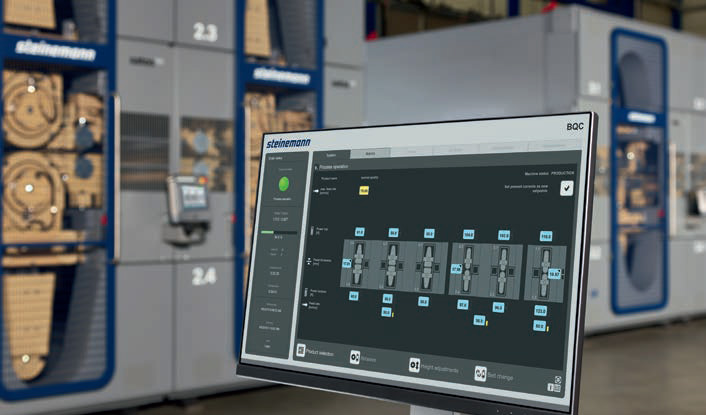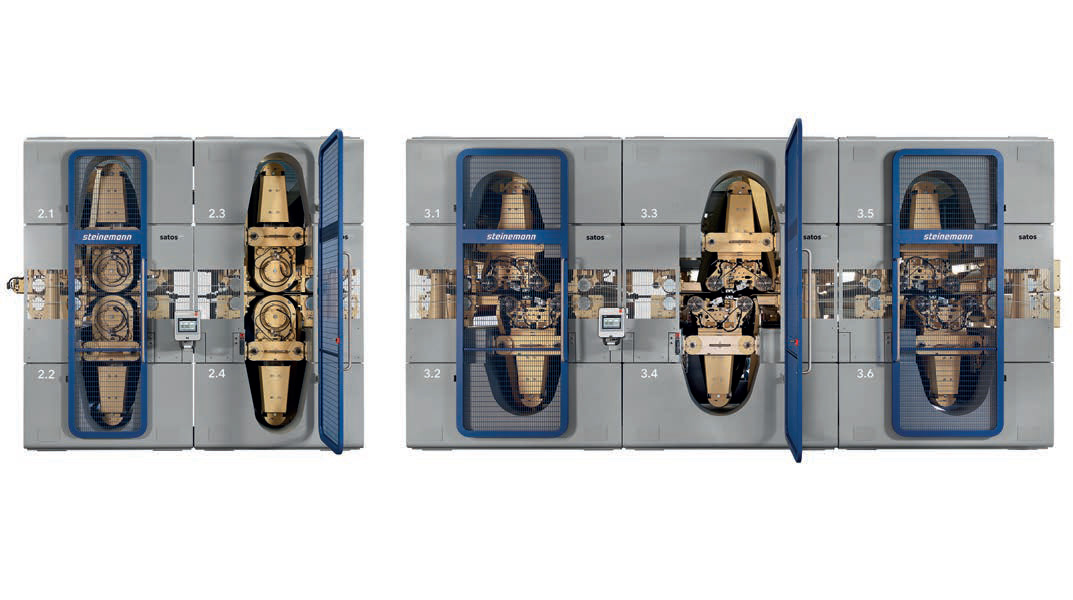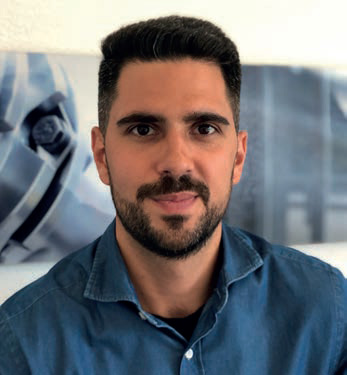Steinemann looks to the future
29 January 2021Swiss wide belt sanding machine manufacturer Steinemann is looking to give panel producers full transparency over their sanding processes and greater quality control. Stephen Powney talks to Sebastian Kohlhase, Steinemann’s product manager, marketing & sales
Based in St Gallen, Switzerland, Steinemann Technology AG has been making wide-belt sanders for the wood based panels industry for over 50 years.
With a 98% export rate, it’s not surprising to see Steinemann sanders represented in all the major panel producers across the globe. The €40m annual turnover company, which employs up to 120 people, has sold more than 200 sanding heads since the introduction of its next-generation satos TSQ (Total Surface Quality) sander in 2017.
When I caught up with Steinemann’s Sebastian Kohlhase in November, he said that although the coronavirus period has been a challenging time, there was confidence due to new orders placed, the activities on the markets and a positive upwards trend.
Mr Kohlhase said when the pandemic started, Steinemann took it very seriously and brought in measures so employees could work safely and enable home working.
“In the beginning, the pandemic meant projects were paused and like everyone in the sector, some key customers’ investments stopped and everything in the months of May, June and July slowed down.
“We weren’t able to enter the facilities of our customers which was challenging and the travel restrictions limited the travelling of our field sales engineers to most places, so we couldn’t follow a majority of our start-up and installation plans.
“Since August and September up until now we’ve experienced more activity in the market, with customers showing willingness to make investments again. And projects could resume. We are looking forward to next year and we see an upwards trend in our projects and sales.”
Remote customer service ensured key communication with customers could continue, helping to ease some processes, while Steinemann retained all its staff and rescheduled production to meet lead times. “The coronavirus has opened up a new avenue which we are dealing with very well.”
Sanding one stop shop
Manufacturing the whole sanding system right down to the belts means Steinemann offers a one-stop-shop service for sanding applications.
“We started production of our own segmented belts 15 years ago so we could have control when it comes to the surfaces customers asks for,” added Mr Kohlhase.
The belts and ancillaries are made in Turkey and China, while the drums and machines are produced at the Switzerland HQ. Other satellite operations such as Charlotte (North Carolina) and Malaysia are sales and service centres. Having control over its sanding technology supply chain allows for a quick response to any customer sanding line issues.
“If you have two parties – one supplying sanding belts and another for the machine – you have ping-pong with the communication.”
“Our strategic focus is on Total Surface Quality - this the main target we follow for every solution for our customers. We are not only looking for single product sales, we are looking at the end result for our customer and adapting our production accordingly.
“We want to continuously improve the process and production of our customers and to do so we have to control all critical fundamental elements that could influence the surface quality and achieve the goal of our customers.”
One-third of satos TSQ machines have been supplied to Asia-Pacific and China, with the majority of them going to China, where Steinemann sees a clear trend towards manufacturing higher quality products.
“They are really interested in process and automation – for example our BQC (Board Quality Cockpit) for the satos TSQ which is the process control system for a fully integrated, automated sanding process.”
Half of all satos TSQ units are sold in Europe and 12% to the US. The satos TSQ bring it all together, incorporating cutting edge software and hardware technology to gain maximum production availability. Key features of the satos TSQ range include vibration monitoring, sanding platen adjustment system, internal thickness measurement, self-adjusting sanding belt oscillation, central touch panel and a drum braking system.
BQC
Ensuring that machine operators correctly operate machines is important and to that end Steinemann has redesigned its training and seminars to effectively share its process know-how with customers.
Even before the pandemic this was a focus area, but use of virtual conferencing has helped to further assist and boost the experience of operators on site. This includes setting-up machines to decide the correct surface results, such as the sanding load, grit sequence and how to use the right belts.
Of course, Steinemann has developed technology to make life easier for operators.
This is especially important when you consider many companies have a high fluctuation of staff and operate different shifts where different setups may be used which influence quality processes.
The BQC board quality cockpit is designed to integrate and automate the complete sanding process. Already globally known, the BQC is fitted on every second satos TSQ leaving Steinemann and can be retrofitted in tandem with machine upgrades.
“BQC is a step in the right direction when it comes to automation and to make production smart, increase efficiency and process performance and to provide a good return on investment,” said Mr Kohlhase. The BQC covers thickness and fine sanding.
“We are targeting these two processes to automate and with the BQC we are able to do this – basically automatically adapt the calibration according to the customer’s desires and remove human error.”
Its Total Thickness Control automates the calibration process, integrating with external thickness measuring to monitor the target panel thickness automatically and allowing fine adjustment of contact drums to ensure a uniform and reproducible panel thickness.
The BQC automation of the fine sanding process - Total Surface Control – integrates the chatter mark and roughness scanner with its software module to control motorised fine adjustment of sanding platens.
“When it comes to fine sanding you want to be aware of the roughness of the surface and the chatter marks,” said Mr Kohlhase. “Normally, operators look at the board and chalk the board as a visual inspection.
But every operator has a different view so there is no consistency. With the chatter and rough scanner, we have a light and camera system to measure the distance of chatter marks and roughness profile and if there is a deviation in tolerances of the standard set by customers it is automatically adapted by the fine sanding unit to get the right result again.
“We want to be aware about the whole process – from the start to finish, continuously aware of the process and responding to customer requirements, adapting to new products, coatings and standards.
“This is a real accomplishment. I think in the future every single sanding line should have this to enable consistent and reproducible panel quality.”
The BQC also give transparency over the whole sanding process, making data available such as machine availability, productivity, downtime and tooling times for the sanding machine operator, line manager and for the top management. This ultimately leads to better decision making and more efficient processes by the management.
Steinemann says it is able to integrate with the customer’s whole production line including handling systems, press and coating lines, to provide high levels of data exchange to boost production performance.
“We are able to communicate with the press and coating systems and we can offer this solution which leads to completely new thinking and reduction of raw materials to gain more efficiency.”
It’s not just regular composite panel products that Steinemann is working on these days. Its background in supplying sanders for multilayer solid wood panels to markets in Austria, Germany, Czech Republic and Finland has given it experience to tap the growing cross-laminated timber (CLT) market in the construction sector.
CLT panels are much wider and deeper than regular panels, but Steinemann is supplying units for the CLT market, including one application in the US. “It is a promising market which is growing exponentially and everyone is fighting for a piece of the cake!”
So, market possibilities in this area and a positive market situation among Steinemann’s regular composite panel producing customers is boding well for the supply of sanding machines, spare parts and consumer belts for 2021 prospects.
“When it comes to our key customers they are full of orders to the end of the first half of 2021 and they keep on running their production.”
In recent weeks Steinemann has received orders for satos TSQ sanders from the Middle East and Africa. “This is encouraging news of their interest and of the upwards trend we are experiencing at the moment.” concluded Mr Kohlhase.


